These easy lemon biscuits consist of a lemon shortbread that is flavored with lemon zest and topped with a tangy lemon glaze.

These lemon shortbread biscuits or cookies are a variation of my plain whipped shortbread. The biscuit itself is flavored with lemon zest and the cookies are topped with a lemon glaze to give it a little extra lemon oof.
If you are really into lemon biscuits or cookies - check out my Lemon Biscotti or Lemon Slice!
Jump to:
The History of Shortbread
There is something magical about the simplicity, ease, and rich buttery flavor that shortbread has to offer. Shortbread originated in Scotland - with traditional recipes calling for one part white sugar, two parts butter, and 3 parts oat or wheat flour. A super easy biscuit recipe that results in a tasty delicious buttery biscuit.
Whipped shortbread is usually made using icing sugar instead of granulated or caster sugar, taking advantage of the added starches in the flour to lighten the flour. But I'm not a big fan of this method and prefer a mix of icing sugar and granulated/caster sugar.
Why You Will Love This Lemon Biscuit Recipe
- These delicious lemon butter biscuits will be a bright spot in your day.
- The cookie dough can be made up to a month in advance.
- These homemade biscuits are the perfect addition to any holiday baking.
- This easy recipe for lemon biscuits comes together in a snap.
- These shortbread biscuits can be rolled out or baked in a tin for easy slicing.
- Enjoy these biscuits with a cup of tea or coffee for a delicious afternoon treat!
Ingredients
Here are some notes on the ingredients used in this recipe. Please see the recipe card for ingredient quantities.
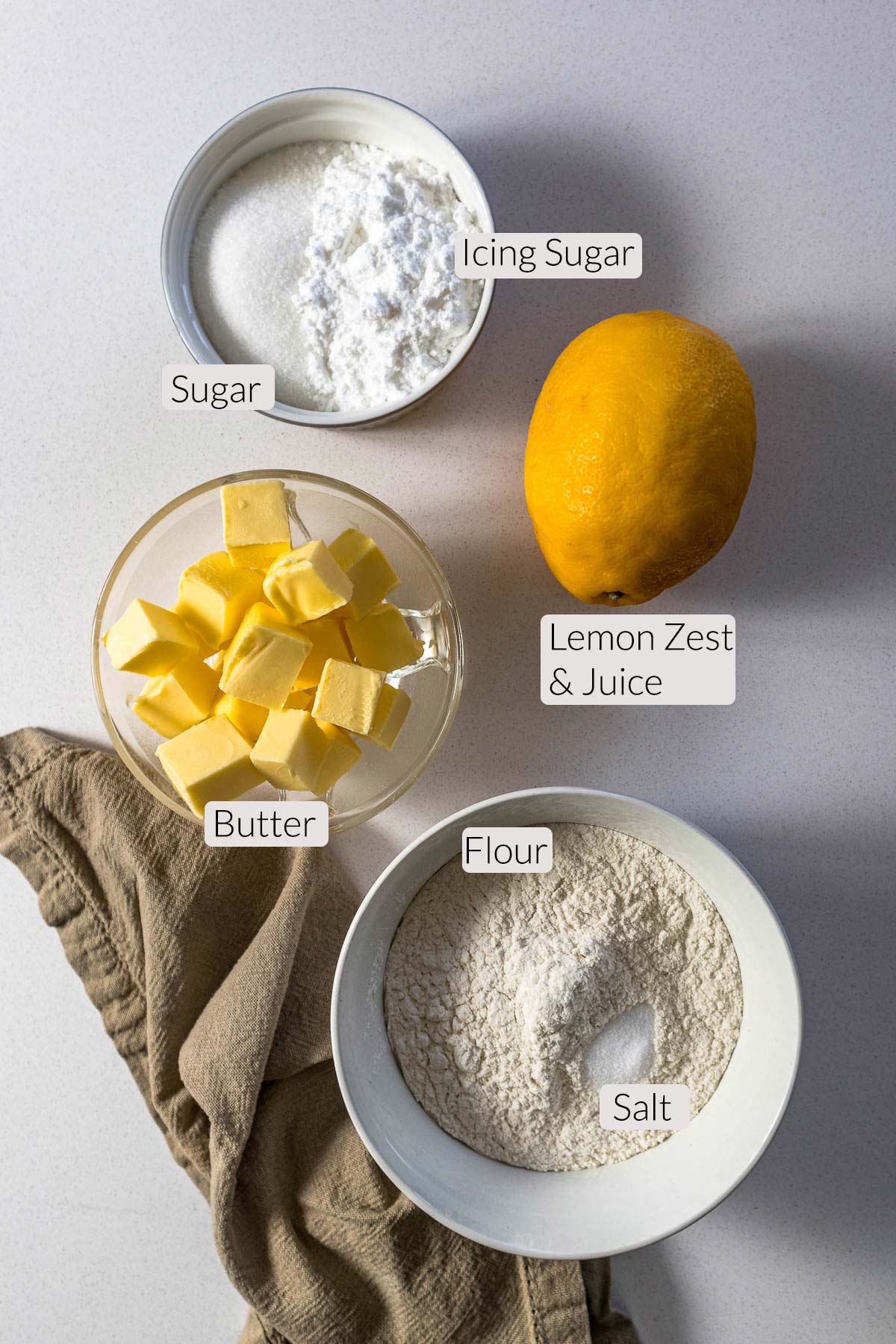
Lemon Zest adds lemon flavor to the biscuit dough, while the lemon juice adds a delightful tang to the lemon icing.
Icing Sugar or Powdered Sugar adds sweetness with the added starches giving the biscuit a tender snap. Using icing sugar plays a similar role as when using cornstarch (Maizena or cornflour in the UK, Aus, and New Zealand) in the biscuits.
Caster sugar can be substituted with white granulated sugar. Plain white or caster sugar gives a crispness to this biscuit that is otherwise completely lost with just using icing sugar
Butter adds flavor, softness, and moisture and sometimes aids in the leavening of baked goods. I use New Zealand butter in my recipes, which has approximately 82% butterfat and can be very yellow (similar to European or Irish butter). Butter cannot be substituted with butter or margarine spreads, but it can be substituted with baking margarine. If using salted butter, simply leave out the additional salt, if using unsalted butter, additional salt is a must!
Plain flour (all-purpose flour/standard grade flour) refers to flour that has a protein content of approximately 9.5-12%.
Salt is a crucial ingredient in all baked goods. I use table salt in all my recipes. One teaspoon of table salt equals 1.5 teaspoons of Morton Kosher Salt equals 2 teaspoons of Diamond Crystal.
Room Temperature Ingredients
Use room-temperature ingredients! Using room temperature ingredients ensures that ingredients in the batter or dough will incorporate easier. Take note that room temperature refers to around 20°C/68F.
- To bring butter to room temperature quickly, cut the butter into cubes and zap it in the microwave at 20% power in 10-second intervals. Or place the cubes in a bowl over warm water (such as with a double boiler) over low heat for 1 minute!
Weighing & Measuring Ingredients
Weighing ingredients with a kitchen scale is more accurate than using measuring cups. All my recipes are developed and tested using grams only.
However, I have activated the metric-to-cup conversions. Simply click on "cups" or "metric" for your preferred measurements. For these conversions, cups are equal to 240 millilitres/8 fluid ounces, tablespoons are 15 milliliters and teaspoons are 5mL.
How to Make Lemon Biscuits
Step 1 - Whip the butter and sugar
In a large bowl (or bowl of a stand mixer), whip the butter, sugar, and icing sugar together until the butter is light. fluffy and aerated.
TIP: The butter must be at room temperature for this step - see my tips on room temperature ingredients above.
TIP: For a more intense lemon flavor, first beat the caster sugar together with the lemon zest before adding in the icing sugar and butter and continuing with the beating.
Step 2 - Add the dry ingredients
Add in the flour, salt, and lemon zest. Mix with a spatula or wooden spoon until a soft dough forms. If using a stand mixer, mixer on low speed until a soft pliable dough forms. Knead the dough 3 to 5 times bringing the dough together in all.
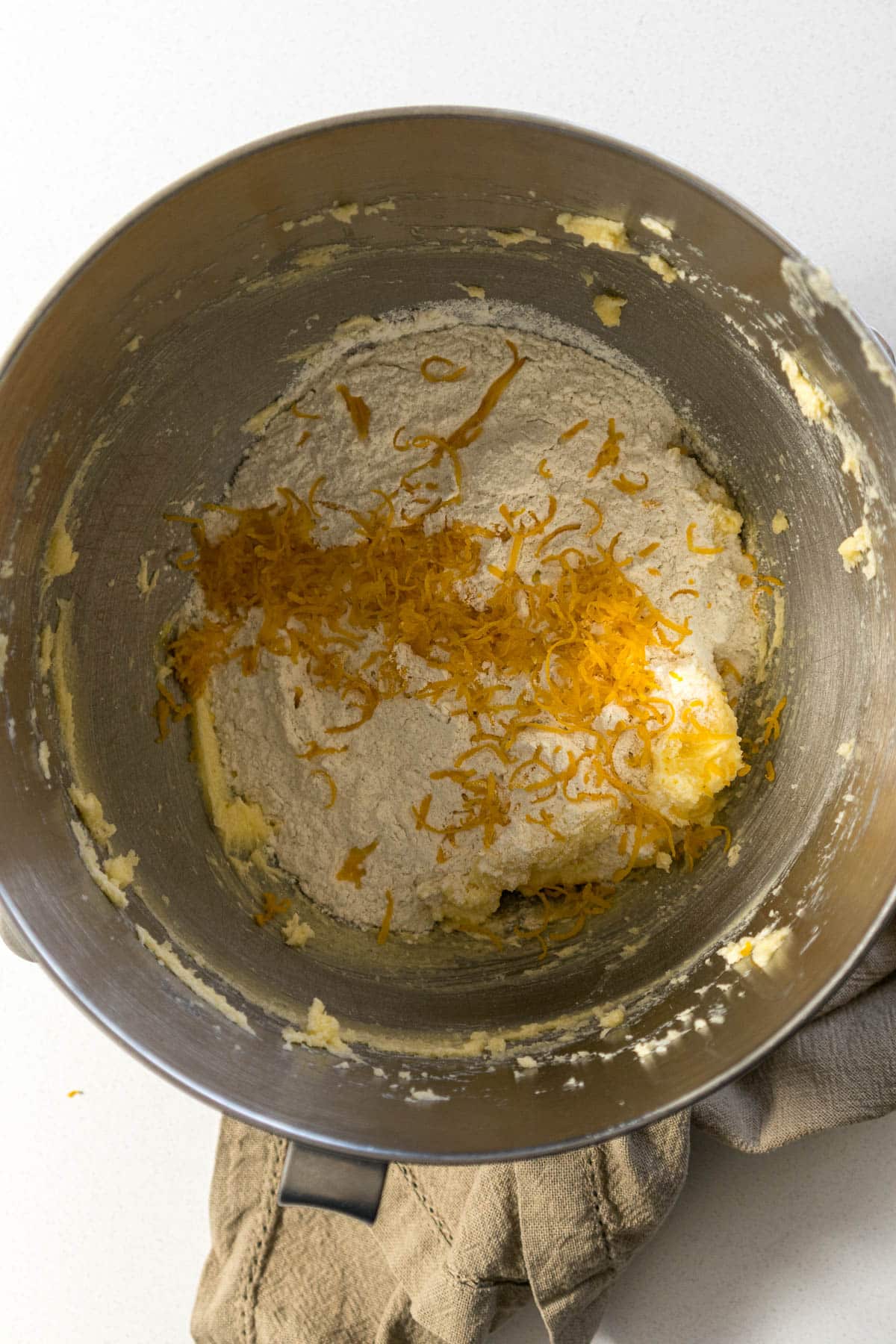
Step 3 - Form the biscuits/cookies
For rolled cookies: Place the dough on a piece of parchment/baking paper and pat it into a rough square shape. Using a floured rolling pin, roll out the dough until between 0.5 and 1cm thick. Then cut the dough using a cookie cutter about 4cm across.
For pressed cookies: Press the dough into a 9-inch square or round cake pan (or tart - lined with baking paper with an overhang for easy removal). Dock or prick the biscuits with a fork.
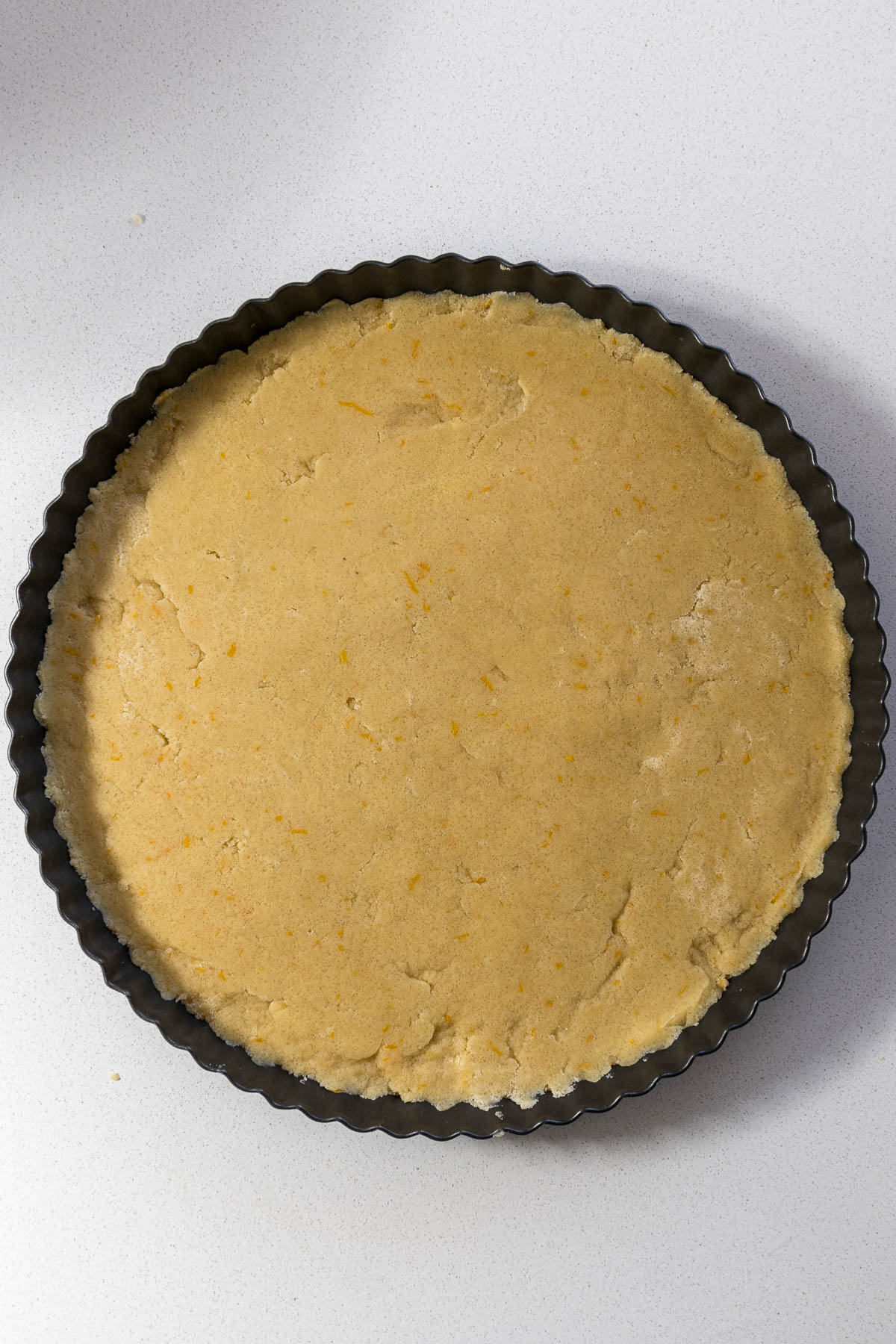
Step 4 - Rest the biscuits in the fridge
Place the biscuits in the fridge for at least 30 minutes before baking.
Step 5 - Preheat and Bake
Preheat the oven to 180°C/355F.
For rolled cookies: Line a large baking tray/baking sheet with baking paper. Place the biscuits on the lined cookie sheet, approximately 3cm apart.
For biscuits that were rolled and cut out, line a baking sheet with parchment paper. Place the chilled biscuits on the lined baking tray and bake for 10-15 minutes. The biscuits are done when lightly golden brown in color. Remove from heat and allow to cool on the baking tray for 10 minutes before gently lifting onto a cooling rack.
For pressed cookies: Bake for 20-30 minutes or until the biscuits are nicely golden brown. Remove from the oven and allow cool on a wire rack. Then lift out of the tin and slice.
Step 6 - Glaze and serve!
In a small bowl, combine the icing sugar and lemon juice and mix to form a glaze. Drizzle the lemon icing over the cooled biscuits, and allow the glaze to set before serving.
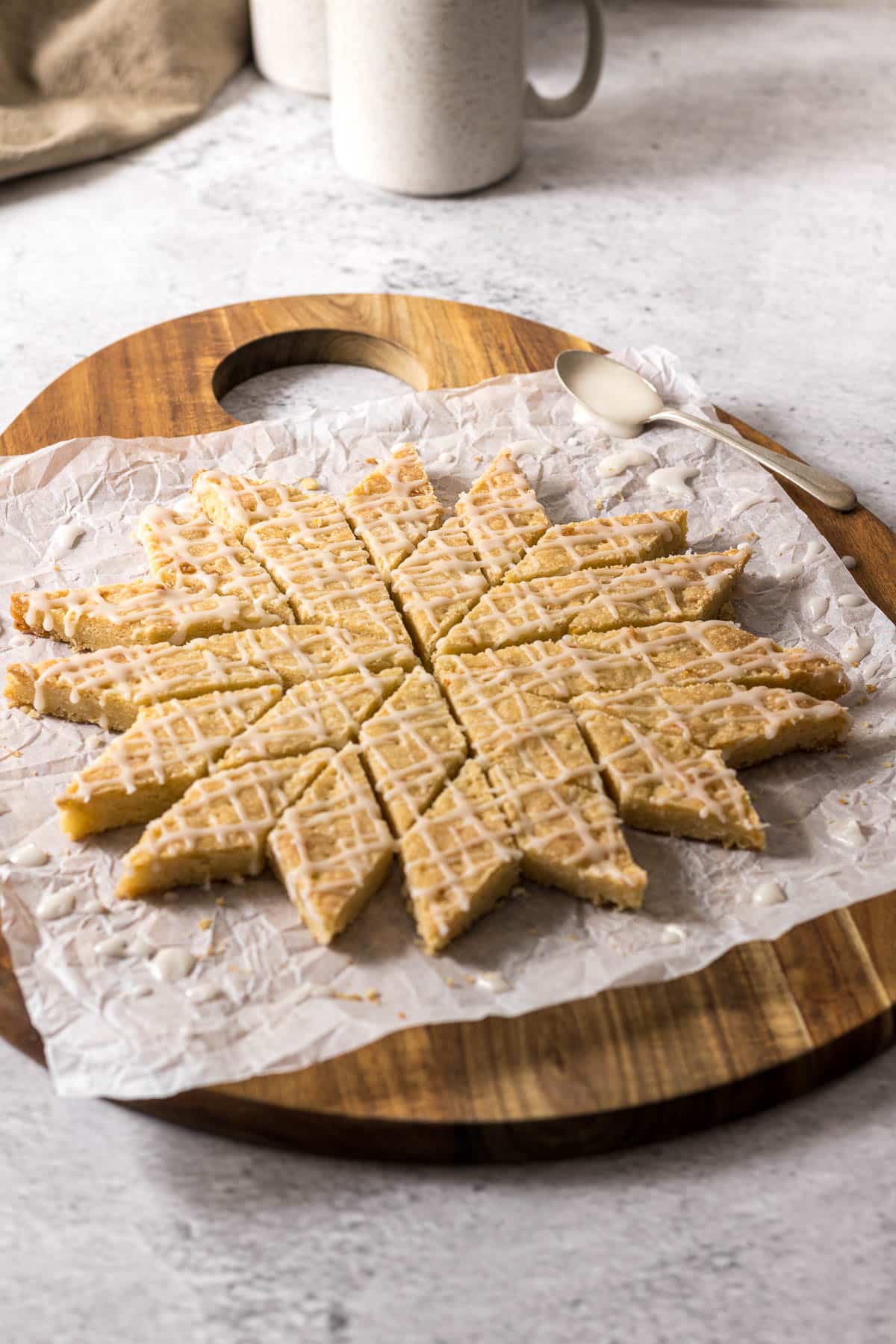
Pro Tips for this Recipe
Room Temperature butter is essential for this recipe. Remember that room temperature is around 20°C/68F. Butter from the fridge can take up to an hour to reach room temperature (depending on the size of the block of butter).
Resting the biscuits in the fridge
Allow the biscuits to rest in the fridge for at least 30 minutes. This allows the cookies to fully hydrate, for the butter to set and allows the flavors to fully develop. Resting the dough will also stop the cookies from spreading in the oven during baking. This dough can also be allowed to rest in the fridge overnight.
Making the shortbread dough ahead of time
If you want to make the shortbread dough in advance, it can be kept in the fridge for up to a week and in the freezer for up to a month. If frozen, simply defrost in the fridge overnight before baking.
Keep in mind that the lemon glaze will need to be made fresh.
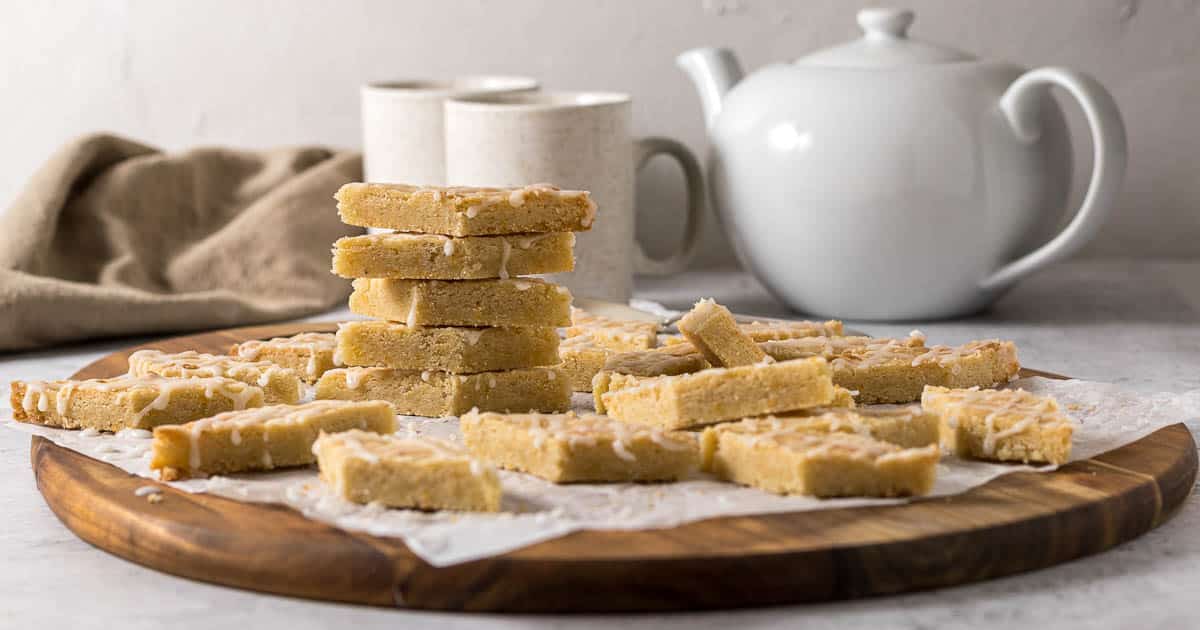
Ovens
The temperatures stated are for conventional ovens. For convection, fan-forced, fan-assisted, or air-fryers, the temperature must be reduced by 20°C/25°F.
For baking, make sure the oven is fully preheated, and that the rack is in the middle of the oven. Open the oven as little as possible. For best baking results use an oven thermometer.
Remember that all ovens work slightly differently and bake times may need to be adjusted for your specific oven.
Bakeware
Metal bakeware is superior when it comes to baking biscuits, cookies, brownies, muffins and quick bread, scones, cakes. These heat up and cool down faster than glassware. Glassware is heavier, heats up and cools down slower than metal, and is more suited for bread puddings, pies, crisps, crumbles, and cobblers.
Storage and Freezing
Biscuits can be stored in an airtight container at room temperature for about 2 weeks. These baked cookies can also be placed in an airtight tin and frozen for up to 3 months.
If you want to make the shortbread dough in advance, it can be kept in the fridge for up to a week and in the freezer for up to a month. If frozen, simply defrost in the fridge overnight before baking.
Lemon Shortbread FAQ
Yes. You can freeze the dough for up to a month and allow it to defrost in the fridge overnight before baking. Or once your baked cookies have cooled, you can place them in an airtight container and freeze them for up to 3 months. If stacking the cookies on top of each other, place layers of baking paper between them to stop them from sticking.
A sturdy plastic container that seals well to create an airtight environment. My go-to are those that have rubber seals in the lid. I am also a big fan of glass dishes that have plastic lids for sealing.
Of course. Your kitchen, your rules!
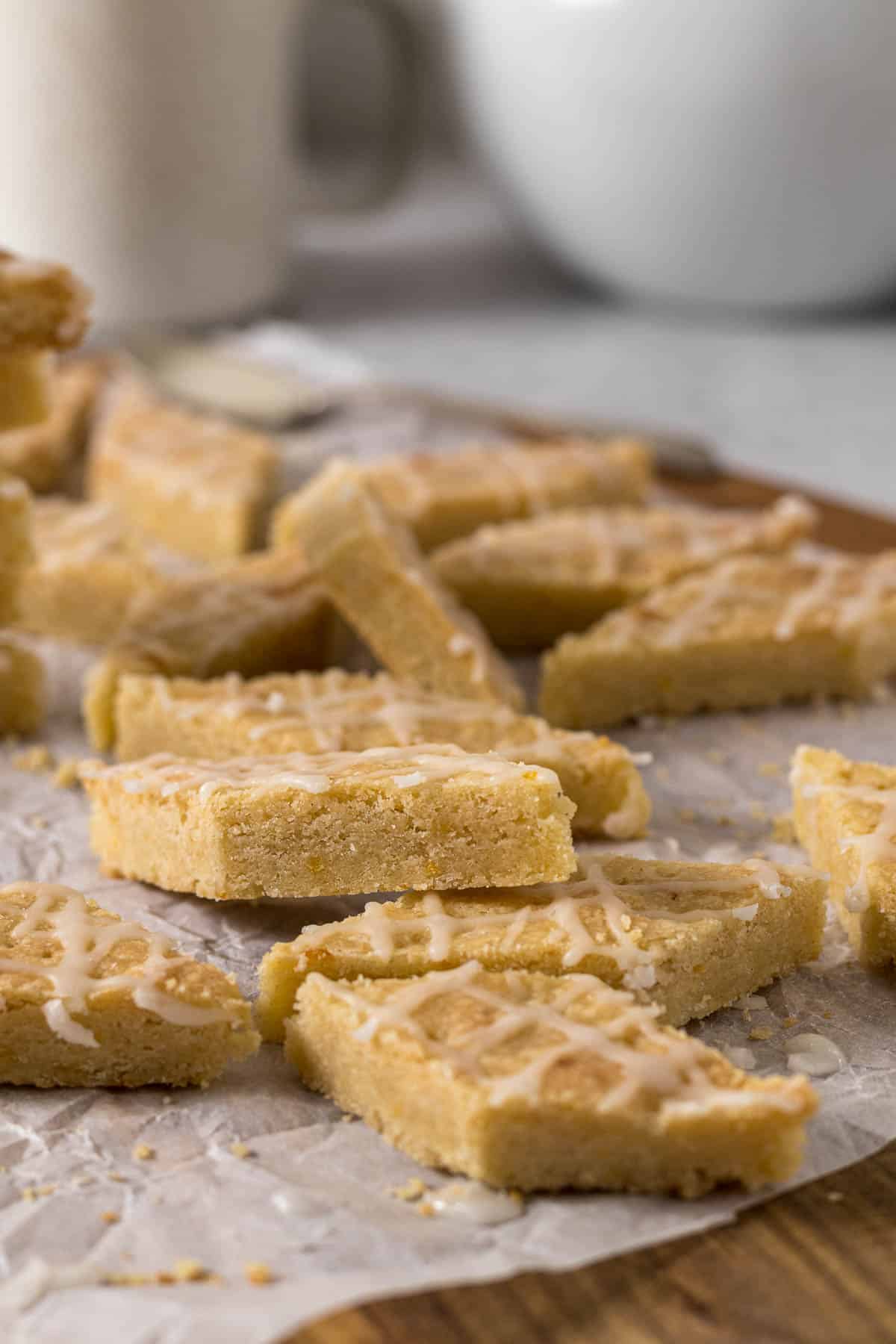
Rate & Review!
If you made this recipe, please leave a star rating! It gives my readers and me helpful feedback. If you want more recipes, subscribe to my newsletter, and follow me on Instagram, Pinterest, and Facebook!
Recipe Card
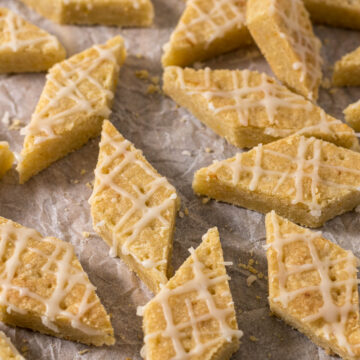
Lemon Shortbread Biscuits
Equipment
- Stand Mixer OR
- Electric hand mixer
- 9x9 Inch (23x23cm) Square Cake Pan
Ingredients
Lemon Shortbread
- 170 grams butter (Room temperature*note 1)
- 60 grams icing sugar (powdered/confectioner's)
- 100 grams caster sugar (fine/superfine sugar *Note 2)
- 240 grams plain flour (all-purpose/standard grade)
- ½ teaspoon table salt
- zest of a lemon
Lemon Glaze
- 60 grams icing sugar (powdered/confectioner's)
- 2-4 teaspoons lemon juice
Instructions
- In a large bowl (or bowl of a stand mixer), whip the butter, sugar, and icing sugar together until the butter is light. fluffy and aerated. *Note 3170 grams butter, 60 grams icing sugar, 100 grams caster sugar
- Add in the flour, salt, and lemon zest. Mix with a spatula or wooden spoon until a soft dough forms. If using a stand mixer, mixer on low speed until a soft pliable dough forms. Knead the dough 3 to 5 times bringing the dough together in all.240 grams plain flour, ½ teaspoon table salt, zest of a lemon
- For rolled cookies: Place the dough on a piece of parchment/baking paper and pat it into a rough square shape. Using a floured rolling pin, roll out the dough until between 0.5 and 1cm thick. Then cut the dough using a cookie cutter about 4cm across. For pressed cookies: Press the dough into a 9-inch square or round cake pan (or tart - lined with baking paper with an overhang for easy removal). Dock or prick the biscuits with a fork.
- Place the biscuits in the fridge for at least 30 minutes before baking. *Note 4
- Preheat the oven to 180°C/355F. For rolled cookies: Line a large baking tray/baking sheet with baking paper. Place the biscuits on the lined cookie sheet, approximately 3cm apart. For biscuits that were rolled and cut out, line a baking sheet with parchment paper. Place the chilled biscuits on the lined baking tray and bake for 10-15 minutes. The biscuits are done when lightly golden brown in color. Remove from heat and allow to cool on the baking tray for 10 minutes before gently lifting onto a cooling rack. For pressed cookies: Bake for 20-30 minutes or until the biscuits are nicely golden brown. Remove from the oven and allow cool on a wire rack. Then lift out of the tin and slice.
- In a small bowl, combine the icing sugar and lemon juice and mix to form a glaze. Drizzle the lemon icing over the cooled biscuits, and allow the glaze to set before serving.60 grams icing sugar, 2-4 teaspoons lemon juice
Notes
- Room Temperature butter is essential for this recipe. Remember that room temperature is around 20°C/68F. Butter from the fridge can take up to an hour to reach room temperature (depending on the size of the block of butter).
- Caster sugar can be substituted with granulated sugar.
- The butter must be at room temperature for this step - see my tips on room-temperature ingredients above. For a more intense lemon flavor, first beat the caster sugar together with the lemon zest before adding in the icing sugar and butter and continuing with the beating.
- This allows the cookies to fully hydrate, for the butter to set and allows the flavors to fully develop. Resting the dough will also stop the cookies from spreading in the oven during baking.
Storage and Freezing
Biscuits can be stored in an airtight container at room temperature for about 2 weeks. These baked cookies can also be placed in an airtight tin and frozen for up to 3 months. If you want to make the shortbread dough in advance, it can be kept in the fridge for up to a week and in the freezer for up to a month. If frozen, simply defrost in the fridge overnight before baking.Nutrition
Nutrition information is an estimate. If scaling the recipe remember to scale your cook and bakeware accordingly. All temperatures stated are conventional, unless otherwise stated. Recipes tested in grams and at sea level.


Comments
No Comments